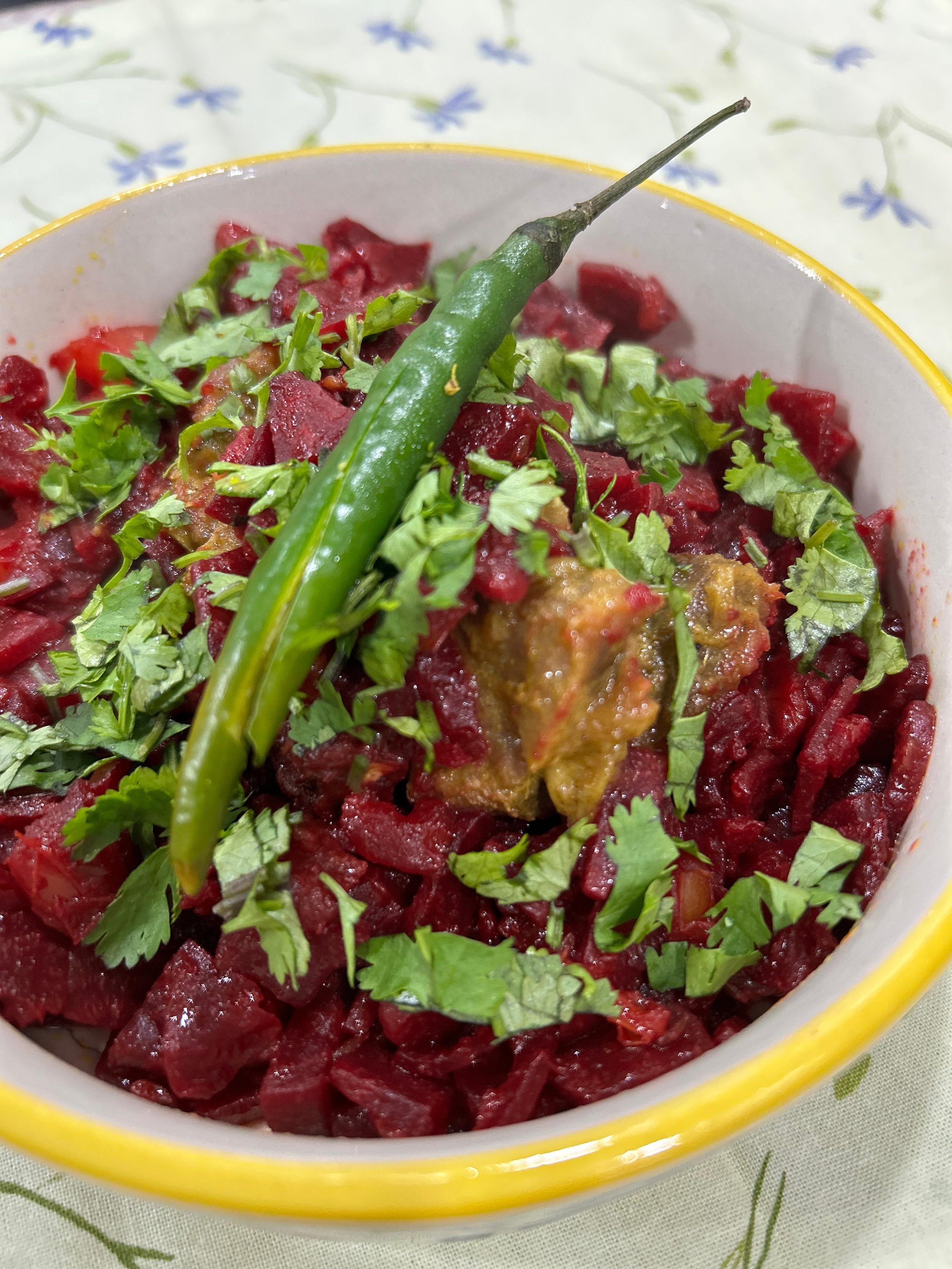Chukandar Gosht: A Syed Family Recipe for Mutton & Beetroot

The winter kitchen in Laraib Fatima Warsi’s home near Lucknow was replete with dishes featuring seasonal greens, mutton, and warming sweetmeats. In an effort to revive these fast-disappearing winter traditions, she has begun to document them. Here she shares a recipe from her home; Find her other recipes, here, and here.
My relationship with the kitchen changed the day I made my nani’s chukandar gosht. The earliest hint of winter was in the air, and an unexpected yearning for the dish led me to attempt cooking it for the first time.
I basked in the compliments from my family, and realised with a jolt how closely food was connected to my family’s collective memories and our heritage. When my father demanded extra rotis at lunch to mop up the last of my gosht gravy, I knew I had done well. I had created a cherished memory.
Coming from a North Indian Muslim Syed family — we belong to Dewa Sharif, a small town near Lucknow — I’ve come to cherish certain traditional dishes that are fast disappearing from the dining tables of many households. Like the chukandar gosht, which is a simple recipe made with onions, turmeric, cumin, red chilli powder and shallow fried tomatoes. It is popular in winter because this is when the best quality beetroots are available. Their earthy sweetness complements the richness of mutton, creating a hearty and warming dish. As my aunt aptly puts it, “These dishes are not just food, they carry the weight of history, culture, and nutritional wisdom passed down through generations. Seasonal vegetables cooked with meat like mutton were designed to nourish us during the colder months, providing necessary warmth and sustenance.”
In our culture, mutton dishes are often associated with special occasions, and the combination with beetroot makes it both flavourful and nourishing. The hearty nature of the dish also makes it perfect for large family gatherings and special winter meals.
It took me more than an hour to cook this fairly simple recipe, only because I decided to use the grinding stone instead of the mixer. That afternoon, as the mutton simmered on the gas stove, my mother and I relived memories of my grandmother. She would often share recipes with the younger women of the family over evening tea in the veranda. Looking back, I see how precious those moments were — traditions passed down, not just in the form of recipes, but through shared moments, conversations, and a deep respect for the process of cooking.
There was a time when traditional winter dishes featured regularly at our dining table. It struck me that these recipes, once passed down with such care and love, were quietly vanishing from our culinary landscape. I realised that if I didn’t do something to preserve and pass them on, they could be lost forever.
Gobhi gosht (cauliflower mutton gravy), saag gosht (spinach mutton gravy), sarson ka saag with keema, bajre ki meethi tikiya and the delicate ande ka halwa are dishes that transformed my family’s winter table into a tapestry of warmth, tradition and love with their seasonal ingredients and robust flavours. Each of these dishes are tied to the rhythm of winter, a time when the family gathered around firewood chulhas in our aangan (courtyard), and the kitchen became the beating heart of our home.
Writing about these dishes became my way of keeping the tradition alive, not just for myself, but for my nephews and nieces, who may never know the joy of these meals unless someone makes the effort to share them.
Recipe for Chukandar Gosht
Ingredients
500 g mutton
500-600 g onion, sliced
4-5 tomatoes, shallow fried
300 g beetroot, sliced
1 tbsp red chilli powder
1 tbsp of of turmeric, cumin powder and garam masala powder
Ginger-garlic paste, to taste
Mustard oil, to taste
Salt, as per taste
Method
In a pan, heat oil and then add slices of onion and let it turn brown on medium heat.
Then add the mutton, ginger garlic paste and salt and stir it well on medium heat. Cook it for a few minutes.
Add turmeric, red chilli powder, cumin powder then half a cup of water, sliced (unboiled) beetroot and shallow fried tomatoes in the pan and cover the lid of the pressure cooker. Allow it to cook for four whistles.
Once it is done, open the lid and saute a bit.
For garnishing, add coriander and garam masala powder and then serve it with rice or roti.
Laraib Fatima Warsi is an independent journalist who is fascinated by people, facts and events. She hopes to change the world, one word at a time.
ALSO ON GOYA












